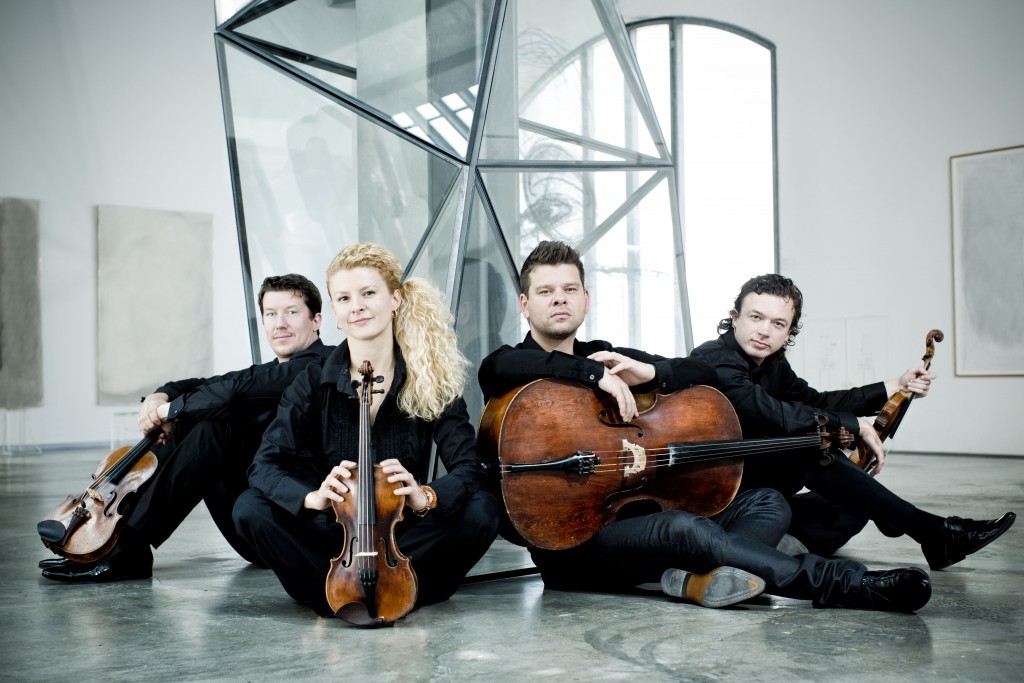Martinů’s music provides the highlight with Pavel Haas Quartet

The Pavel Haas Quartet performed Thursday night at Pickman Hall for the Celebruty Series. Photo: Marco Borggreve
The Celebrity Series of Boston launched their fourth year of its “Debut Series” at the Longy School’s Pickman Hall on Thursday with the first Boston performance by Prague’s Pavel Haas Quartet. Named after Czech composer and Holocaust victim Pavel Haas, the ensemble paid homage to their Bohemian heritage with works by Bohuslav Martinů and Antonín Dvořák, and closed the concert with Beethoven’s second Razumovsky quartet.
The quartet opened the program with a bold 20th-century choice, Martinů‘s 1929 String Quartet No. 3. The Allegro begins with dry timbres of strummed cello and col legno battuto from the viola over which a pleasantly rambling melody and its chromatic counterpart emerge in the violins. These timbrally distinct layers were kept in perfect balance both here and in their recapitulation at the close of the movement.
Along the way, each instrument and combination were given their own lyrical moments, which, while intensely expressed, never veered into the maudlin. Peter Jarušek’s intriguingly reedy cello tone and Pavel Nikl’s smooth viola sound lent particular interest to the twists and turns of the thematic material. The Andante further highlighted the lower strings, as well as the quartet’s seamless blending in tutti sections. The quartet rendered even the rough scratch tone that follows the final tutti passage with a tragic beauty.
Martinů ‘s final movement, marked Vivo, elicited from the quartet a stirring energy that never flagged, even through glissandos, pizzicato passages, subtle changes in texture, and splashes of humor and fury. The Pavel Haas Quartet’s inspired performance of Martinů’s elongated melodies, piquant harmonies, and novel sounds rendered its contemporary aesthetics in moving fashion.
Dvořák’s String Quartet No. 9 in D minor, Opus 34, proved to be a tepid companion to the Martinů. The Pavel Haas Quartet gave an adequate rendering of the opening Allegro’s Romantic melodies and catalogue of arpeggiated, pizzicato, and tremolo accompaniment figures, but the bold energy applied to the Martinů was missing here. Perhaps the traditional materials and forms were too comfortable and familiar to inspire the ensemble.
Nevertheless, the Dvořák did keep the spotlight on the quartet’s ability to balance textural layers in the melody and accompaniment sections, and seamlessly blend their sounds in tutti passages. There were a few moments that stood out: a striking shift of color for a subito piano motif in the Allegro’s development and a lovely duet between the first violin and the cello in the Finale. The Adagio fared the best of the four movements. The quartet took their time with this slow movement, allowing it to blossom into passages of high emotion that now and then threatened to upset the cool clarity of the performance.
The Pavel Haas Quartet regained their initial intensity for a compelling performance of Beethoven’s String Quartet in E minor, Opus 59, no. 2, the second of the set dedicated to Count Razumovsky. The opening Allegro movement was at its best in its most agitated thematic material, rather than the lyrical melodies, which were too restrained in the quartet’s hands.
For the second movement, marked Molto adagio, the quartet finally left their timidity behind for good, and fashioned an emotionally compelling narrative out of Beethoven’s melancholy themes. Likewise, the Allegretto, while a touch too fast, achieved a satisfying contrast between the darker tutti sections and the alternately playful and triumphant secondary theme. In the Presto finale, the quick tempo resulted in an energetic rendering of the crisp, galloping main theme and brought the concert to a rousing conclusion.
Posted in Performances